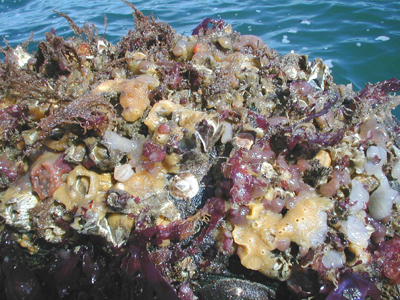Protection & Defense on the FHL Floating Docks
Within the floating dock habitat, several
methods are used by different organisms for protection from predators and
physical disturbance. The float substrate we examined was composed
of rubber tires; therefore, lifestyles of the float community are adapted
for living on a relatively hard surface. For example, organisms on
floats cannot escape aerial exposure or predators by burrowing into their
substrate (for more information on living in soft-sediment substrates,
see False Bay). Many
of the organisms living on the floating tires are sessile (see locomotion)
and therefore cannot move away to protect themselves from danger.
Some sessile organisms
construct hard exoskeletons which they use for protection. Polychaete worms,
such as members of the serpulid, spirorbid and sabellid families, secrete
tubes into which they withdraw when threatened. Barnacles also secrete
a hard exoskeleton, including several plates at the top opening that can
be closed tightly.
Numerous other organisms within the
float environment use exoskeletons as a means of protection or defense.
Many molluscs (such as mussels, limpets and chitons) have calcareous shells
that protect them from predators. Crabs also have hard exoskeletons and
are equipped with pinching claws to defend themselves. |

|

|

|
| Decorator crabs are commonly found
on the floats. They accumulate other organisms (such as algae, bryozoans
and other sessile animals) on their carapaces for camouflage. Here is a
decorator crab well-camouflaged in a covering of the "potato chip
bryozoan", Dendrobeania lichenoides. For more information
on decorator crabs, click here. |
Also present on the floating docks,
the small cancer crab Cancer oregonensis tends to rest in small
holes and can often be found hiding in empty Balanus nubulis barnacle
shells on the float tires.
|

|
Although the bryozoan Bugula pacifica
may resemble a branching plant, it is actually a colony of many tiny animal
units (zooids) that build and live in the branching structure shown in
the picture to the left. Many bryozoans have different types of zooids
that perform special functions--such as feeding, protection and reproduction--for
the colony. Bugula pacifica has specialized zooids, called
avicularia, that help to defend the colony from unwelcome settlers. Resembling
bird beaks on long stalks, avicularia keep the colony surface clean by
pinching visitors who settle on it.
Click here
to see a (fuzzy) movie of the highly magnified avicularia and feeding polyps
of a Bugula pacifica colony. In the movie, you will see the
beak-shaped avicularia swinging and snapping in the water. Look at
the bottom right corner of the screen to watch a feeding zooid (a polypide
with delicate tentacles) retract into its chamber.
|

Other organisms inhabiting the floats
defend themselves by chemical means. Sea anemones contain nematocysts,
or stinging cells, which are used for capturing prey but also for self-protection
(see feeding for more information
about nematocysts). Commonly found on the FHL floats, Metridium senile
(the white sea anemones shown above) often exudes white threads called
acontia (containing nematocysts) when it is disturbed. Nematocysts
are fired from the acontia to sting all that come in contact with them.
To see a movie of firing nematocysts, click here
and watch for the slender filaments as they corkscrew away
from the edge of the tentacle.

The nudibranch Phidiana crassicornis
has an interesting method of defense. This gastropod is able to ingest
the stinging capsules of the hydroids it eats and store the unexploded
capsules in the tips of its cerata (the fleshy projections along its body)
for its own defense.
Another organism which has a very unique
means of defense is the sea cucumber Eupentacta quinquesemita. This
small cream-colored echinoderm (up to 10 cm long) can be found hiding in
crevices on the float tires. In times of high stress, the animal can purge,
or eviscerate, some of its internal organs out the mouth. It leaves
the ejected material behind as a distraction to the predator, and the organs
later regenerate within the animal.
For more information on how different
marine invertebrates protect themselves in their natural habitats around
San Juan Island, visit the following web pages:
Argyle
Creek
Cattle Point
False Bay
Plankton
Back







